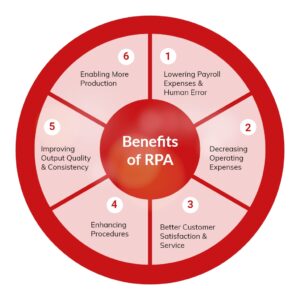Robotic Process Automation (RPA) is the method through which a software bot automates repetitive, high-volume, rule-based, and trigger-driven processes using a combination of automation, computer vision, and machine learning.
Organizations should assess their readiness to employ RPA technologies by looking at their data management procedures and architecture before implementing them. For RPA to succeed, high-quality data and effective data governance are essential. Without the proper safeguards (such as a center of excellence, governance boards, and written guidelines), it won’t meet the business’s demands.

Business Advantages of RPA
Workflows are streamlined by robotic process automation, which helps businesses become more profitable, adaptable, and responsive. Removing day-to-day tasks from their workdays also boosts employee satisfaction, engagement, and productivity.
RPA Tools
The RPA industry comprises brand-new (specially designed solutions) and older technologies that have been updated with fresh capabilities to facilitate automation. Some of these were initially tools for Business Process Management (BPM). The terms “workflow automation” and “work process management” are used by some vendors to describe their products.
The global market for RPA software is anticipated to increase from $2.4 billion in 2021 to $6.5 billion by 2025.
10 Standards for Selecting RPA Tools
When selecting RPA tools, we need to keep these 10 things in mind:
- Easy setup of a bot
- Observed v/s Unobserved
- Capabilities of machine learning
- Low-code potential
- Administration and coordination
- Handling of exceptions and human evaluation
- Adaptation to business applications
- Cloud robots
- Mining for process and task discovery
- Scalability
10 Suggestions for Efficient RPA Utilization
Here are some pointers for using robotic process automation effectively.
- Know What Needs to Be Automated
- Organize and Control Expectations
- Concentrate on Specific Goals
- Start by Using Premade Solutions
- Automate in Stages
- Conduct a Cost-benefit Analysis.
- Include IT Department
- Think Long Term
- Prepare in Advance
- Start with Established Procedures
Using RPA to Fill Integration Gaps
One of its initial advantages is robotic Process Automation’s capacity to integrate systems where gaps previously existed. Enterprises that need to integrate legacy systems or external sites for daily operations but do not now have the resources or tools to do so can use bots. Fast deployment and simple updating allow for automated data and process synchronization. By swiftly deploying integrations that sync data and processes without requiring human intervention, bots help enterprises create more comprehensive, end-to-end automation solutions.
RPA for Digital Transformation
RPA can be a useful tool for overcoming automation difficulties and encouraging businesses to develop into digital workplaces. RPA is a potent addition to any business process automation platform, whether optimizing end-to-end automation campaigns or helping staff manage projects more effectively.
If you are targeting RPA consulting or RPA solutions, contact Perficient, who are ready to help you in every possible way.

